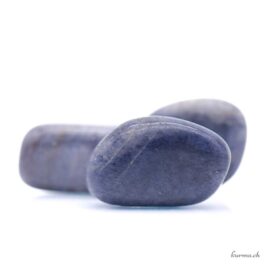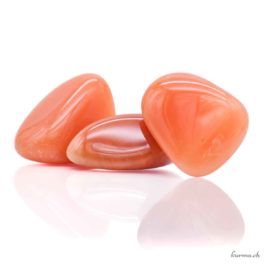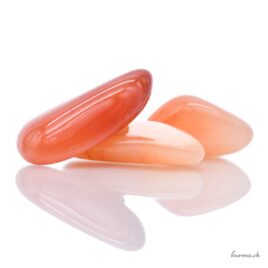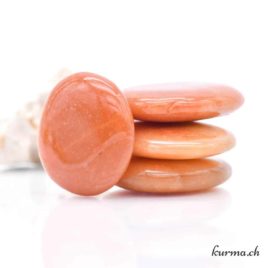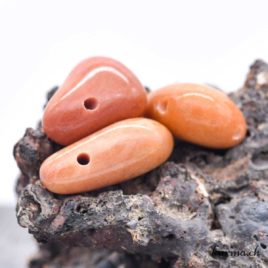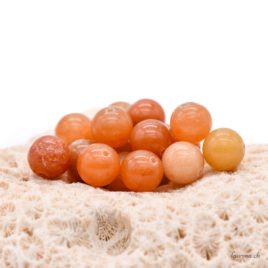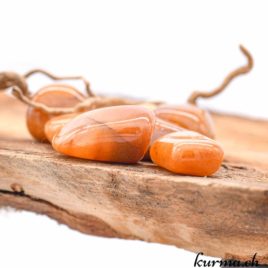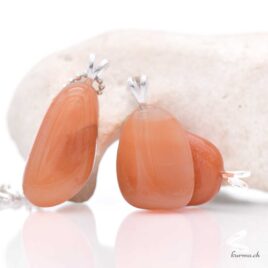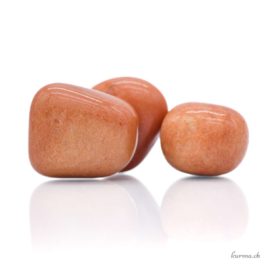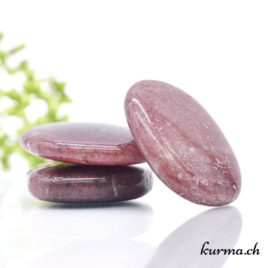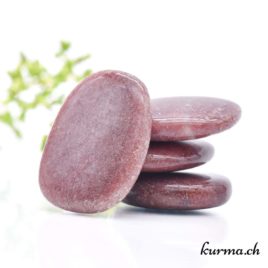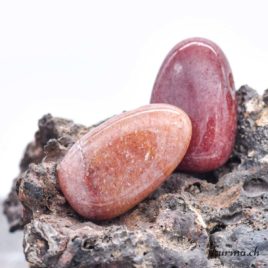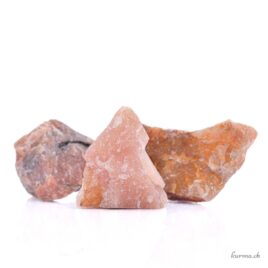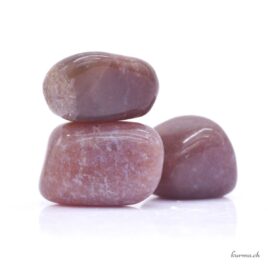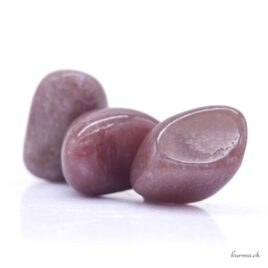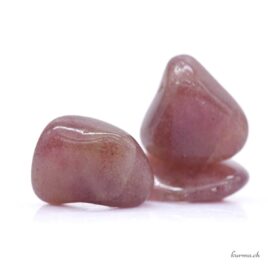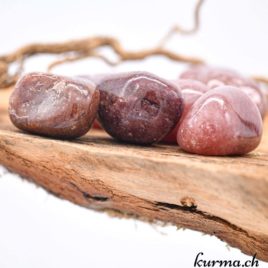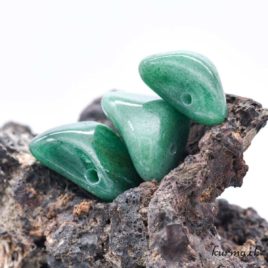Aventurine
gemstones in green, light green, blue, red, orange, peach and violet.
Whether it's green, blue, red, orange, violet, or any other shaded or clear color,Aventurine is a fine semi-precious stone
that invites you to move forward without fear and gives you the courage to dare to step out of your comfort zone.
In lithotherapy, this lucky stone is much appreciated by sensitive children and shy people.
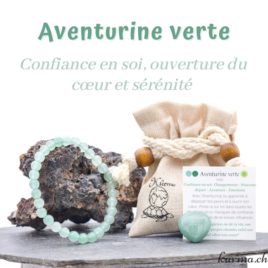
What are the virtues and powers of Aventurine in lithotherapy?
What is the significance of this stone?
Aventurine represents freedom of spirit, life-saving change and knowledge. Green Aventurine, the opening of the heart and the link between one's heart and one's environment.
Did you know? Aventurine is often referred to as the gambler's stone because of its reputation for bringing good luck. It is also said that placing 3 Aventurines in a dish in front of a garden gnome would bring fortune to the house.
What are its benefits?
Aventurine encourages you to take charge of your life, to stop being a victim or a sufferer. It helps you to move forward without fear and to make the right choices, reminding you of all the magic you have within you and in which you can have full confidence. As the name suggests, it's all about adventure.
Full of audacity, courage and great life force, it is the perfect stone to accompany changes in your life, such as new projects, new beginnings, a change of partner, work, place of living or exams .
She is the perfect companion for children experiencing difficulties at school, teenagers undergoing the many changes associated with this stage of life, hypersensitive or hyperactive people, or anyone who has often been belittled and lost self-esteem (especially in the case of harassment at school, at work or within the family).
What are the magical properties of the different Aventurine colors?
Each Aventurine color has its own virtues and is linked to the elements of which it is composed.
Virtues of green Aventurine
It is the stone of the heart, the one that soothes wounds, helping them to heal so that your heart can open up to yourself, to others and to your environment. Green Aventurine's spiritual virtues are particularly suited to young people and highly sensitive children who are experiencing difficulties in their relationships with others, and to people who are suffering from a break-up (in love, in friendship, within the family). The Fuchsite present in this stone adds energetic protective properties, welcome when you feel like an "emotional sponge".
Virtues of Aventurine orange
Aventurine orange is a warm and positive stone that invites you to shine, to open up to others, to say a big "YES" to life, to dare to be adventurous, to dare to allow yourself happiness. Aventurine orange's properties invite you to enjoy yourself, to be creative, to feel hopeful, to want more and turn away from gloom towards the sun. With its Biotite and Muscovite inclusions, it offers excellent protection against electromagnetic fields and the influences of undesirable energies.
Virtues of red Aventurine
Particularly energizing and grounding, Red Aventurine helps you to stay focused, reinforces your self-determination, courage, autonomy and free will. It is the perfect companion to help free yourself from emotional dependencies.
Virtues of blue Aventurine
Blue Aventurine helps clear blockages in the throat and is well suited to shy people who have difficulty communicating with others. It can also be used to soothe anxiety, nervous tics and excessive stress.
What are the physical properties of Aventurine?
Aventurine is used to relieve skin problems such as eczema, acne, psoriasis, and in general any itching, especially when skin eruptions are caused by nervousness.
In the case of local eczema, Aventurine can be bandaged over the affected area.
Green Aventurine can act as a cardiac regulator and relieve tachycardias, palpitations and arrhythmias. It can also help repair heart tissue after surgery. In general, it's a stone of choice for anything to do with the pericardium.
How do I use an Aventurine?
- For skin problems or to benefit from its anti-wrinkle properties, massage the affected area with a polished Aventurine pebble, massage stick or massage roller.
- Keep an Aventurine with you in times of change or use it to accompany your positive visualization sessions. Combine it with Citrine to boost your self-confidence and invite prosperity and luck into your life.
- Wear it as a talisman in case of harassment or when you have to deal with people who tend to make life choices for you.
- For difficulties related to hypersensitivity, hyperactivity or a DYS disorder, you can combine Aventurine (which will help you better manage your emotional side) with Fluorite (which will help you better structure your ideas and concentrate). If you have a language disorder or difficulty expressing yourself, you can combine green Aventurine with Sodalite.
Where to place an Aventurine?
- To enjoy its benefits all day long, place it against you, in your pocket or bra, or wear it as a piece of jewelry.
- An Aventurine in your home will bring a touch of magic and be the perfect companion at every stage of your life.
- In the workplace, it will motivate you to make your own decisions and have confidence in your abilities, whatever your colleagues or superiors may say.
- On a child's desk to encourage homework. Or in his pocket, for school, especially when the child arrives in a new class.
- In your backpack when you're out and about.
- In your car, on your bike or motorcycle to accompany all your adventures.
Purify green, blue, orange or violet Aventurine
Reloading and cleaning stones
Sun, running water, fumigation, wind/breath, intention, singing bowl, form waves, prayers, earth...Associated astrological signs
Cancer, Aries, Taurus and LibraChakras
Green or pink aventurine: 4ᵉ chakra - Heart
Aventurine orange: 2ᵉ chakra - Sacral
Red aventurine: 1st chakra - Root
Blue aventurine: 5ᵉ chakra - Throat
Element
Depending on its colorAventurine in mineralogy
Aventurine is a Quartz of the oxide family composed of silicon dioxide, potassium and aluminum, as well as inclusions of various minerals that give it its color palette. Inclusions of fuchsite (chromium-rich mica) give it its green color, lepidocrocite (iron oxide) and hematite (magnesium and titanium) its pink-red color, dumortierite its blue color, and biotite and muscovite its orange color.
It forms mainly at depth, at high temperatures between 700 and 1100°C, from liquid magma under very high pressure. Its crystal system is rhombohedral, but foreign substances in the mineral prevent crystals from forming, creating coarse clusters.
Aventurine is characterized by the iridescence of mini glass-like elements, creating what is known as "aventurescence".
Aventurine, its history and legends
Its name comes from the Latin "a ventura" , meaning "at random", in reference to the "flakes" scattered randomly throughout the stone.
Aventurine has been widely used throughout the world over the centuries, and numerous carvings have been found in Ethiopia, India, South and North America and Tibet.
Among the Etruscans, it was associated with Thalna, goddess of childbirth, and in China, with Guanyin Pusa, goddess of compassion and unconditional love. Among the Amerindians, during ceremonies linked to the medicine wheel, participants wore an Aventurine on their hearts to connect with the spirits through the heart.
For the Celts, it represented knowledge and was considered a spiritual resource, and used in various magical rites.
In Tibet, Aventurines are often found on the eyes of statues. Popular belief holds that Aventurine improves myopia.
Today, it is recognized and widely used as a therapeutic stone, particularly green Aventurine.
Lithotherapy
Mineralogy
- Hardness :
- 6.5-7.0
- Moths scale:
- 6, 7
- Strunz classification :
- Silicate
- Crystalline system :
- Trigonal
- Chemical element :
- Si, O
- Line color :
- White
- Density :
- 2.63-2.39
- Cleavage :
- No
- Fracture:
- Conchoidal, splitting
- Transparency :
- Translucent to opaque
- Refringence :
- 1,544 -1,553
- Birefringence :
- +0,009
- Pleochroism :
- Null
- Fluorescence :
- Inert UVL/UVC
- Colors :
- Green, orange, red-brown and blue
- Magnetism :
- no
- Radioactivity :
- no
Other stones to relieve skin problems
*Please note! Some minerals may be toxic and must not be licked or ingested (as such or in the form of powder, elixir or stone water) or be in prolonged contact with the skin or mucous membranes.
*The information on the stones described here are general indications based on our research and experience, and are not exhaustive.
Reproduction in whole or in part of this content is prohibited. More info






